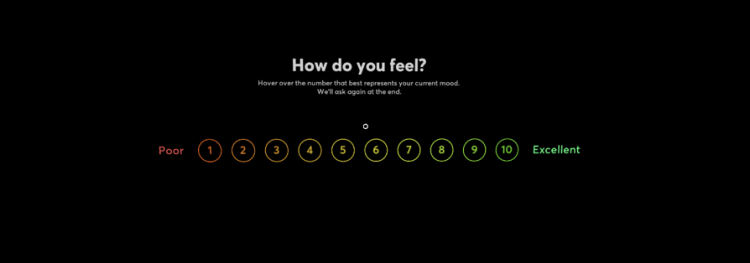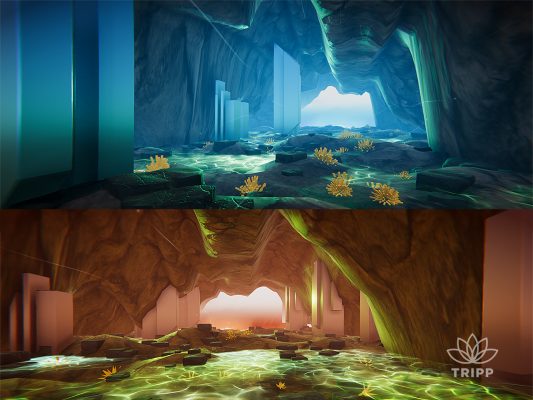For as far as you can see, brightly colored clouds—pink, purple, and gold—stretch across the sky, a psychedelic backdrop broken by the zigzagging branches of neon trees on the horizon. A flock of birds pass by and, as you move your head, you realize you’re in control of them. The flock drifts with a group of lanterns hovering in midair, shattering into dozens of motes of light.
Sound relaxing? TRIPP, a company that creates virtual reality (VR) experiences that aim to trigger mindfulness, is betting on it.
The immersive experiences are designed to give users some of the same benefits as meditation: focus, calm, and a greater appreciation for the present moment. TRIPP CEO and co-founder Nanea Reeves says the experiences really work: 80% of their users report an average 25% increase in their mood.
How does she know? TRIPP used SurveyMonkey’s API to build surveys into their product in order to ask users to rate and describe their mood before and after every VR experience.
Using only the movement of their heads, users rate their mood on a scale of 1 to 10 and choose from a list of options that best describes how they're feeling. In this way, users can see whether their moods improve from the experience and can track changes to their overall mood over time.

Perhaps more importantly, the data TRIPP gets from its surveys plays an integral role in their product development strategy—and their business strategy as a whole.
“Measurement is everything to us as a company,” Reeves said. “To understand whether our product is effective or not was so important that we made it an actual part of our product experience.”

Using survey feedback to continually optimize the VR experience
TRIPP changes the VR experiences nightly to ensure they remain fresh and stimulating. But when the experiences are constantly changing, how do they know which type is most effective? Do people prefer to float in the sky or stay closer to the ground? Do they want mellow, nature-based environments or flashing lights in space?
These are the types of decisions TRIPPs experience designers make with the help of their survey data. TRIPP’s designers adjust their content pipeline based on user feedback in their surveys and make changes to individual experiences in order to improve user experiences in the future.
“If we find experiences with low ratings that people weren’t responding to well, we’re able to immediately take out those out of rotation and analyze if there were any patterns or attributes they shared,” Reeves said. “The feedback data is often what proves our hypotheses right or wrong. It’s a very rapid feedback loop that’s absolutely invaluable to us.”

For example, TRIPP found that “realistic” nature environments caused more stress than relaxation for most users. Although it looked to them like they were walking through a beautiful forest, the dissonance their brain felt at not being able to smell the fresh air or feel the moisture on their skin tended to make them anxious. Without survey data, TRIPP may never have uncovered that insight.
TRIPP also found interesting differences when looking at the data through a demographic lens: Men tend to like to float through VR environments, while women seem to like to be closer to the ground.
These findings and differences make real and significant impacts on the types of content TRIPP decides to put in front of its users and by extension, the success of its program overall.
Broadening the scope of VR-triggered mindfulness
When TRIPP first launched in December of 2018, it marketed itself primarily to companies with corporate wellness programs. One customer, a content moderation company, had a special cause to provide relaxing ways to boost employee mental health.
“They spend their days training algorithms to identify content that nobody wants to see in their social feed—child pornography, animal cruelty, things like that,” Reeves said. “It’s a tough job that creates a lot of stress, even trauma, so the company brought in TRIPP to help employees cope.”
If the prospect of offering a virtual reality as a form of therapy sounds far fetched, the National Institutes of Health (NIH) would beg to differ. In October 2019, the NIH awarded TRIPP and mobile peer support network Sober Grid a $1.7-million grant to study the effect of their technologies on addiction recovery.

TRIPP’s plan is to offer VR as a form of intervention. When a patient starts and ends an experience, they rate their level of craving in the survey instead of rating their mood. In this way, the designers at TRIPP can change the experience to attempt to reduce patients’ level of craving.
“We’re testing it in three categories: stimulants, opiates, and alcohol,” Reeves said. “If opioid users tend to want to retreat and meth users want to be stimulated, we can modify their experiences on TRIPP to match. The most exciting thing is addiction recovery data isn’t typically collected in real time, and the fact that we’re capturing it in that way I think makes it special.”
Now, TRIPP is scaling its service far beyond corporate wellness customers and addiction recovery. In December 2019, TRIPP released its VR app into the consumer market so that everyday VR users can use it to try to achieve mindfulness at home.
Imagine, Reeves said, how much TRIPP could help people with survey data from a massive consumer audience.



